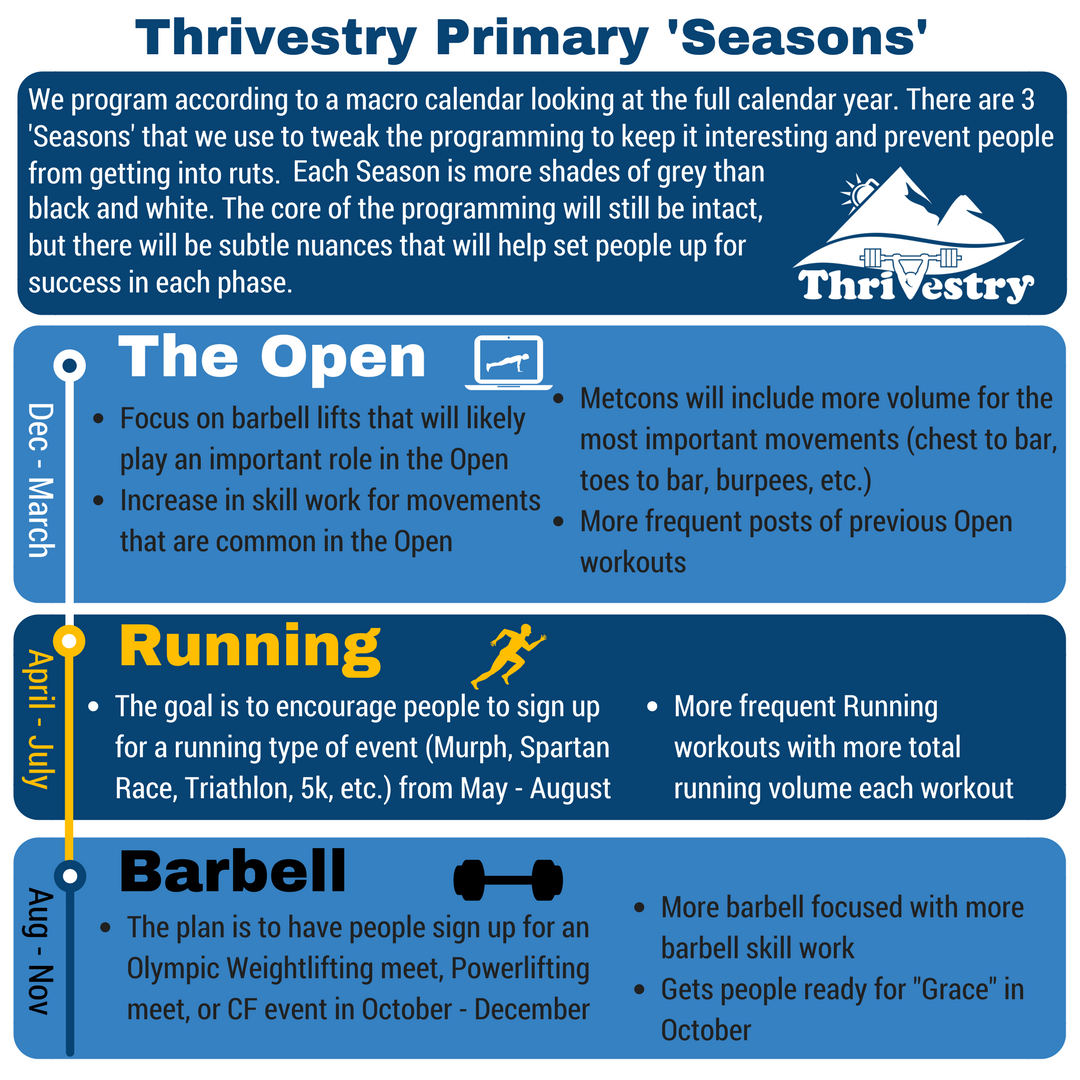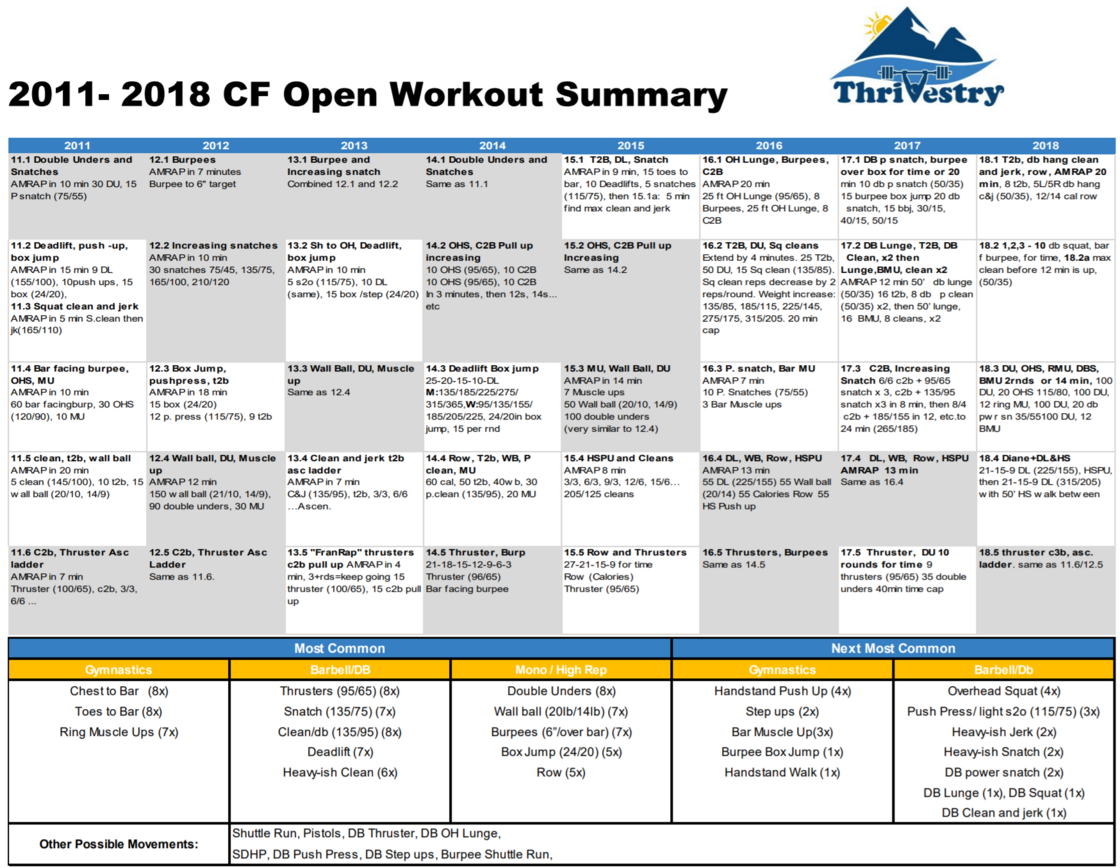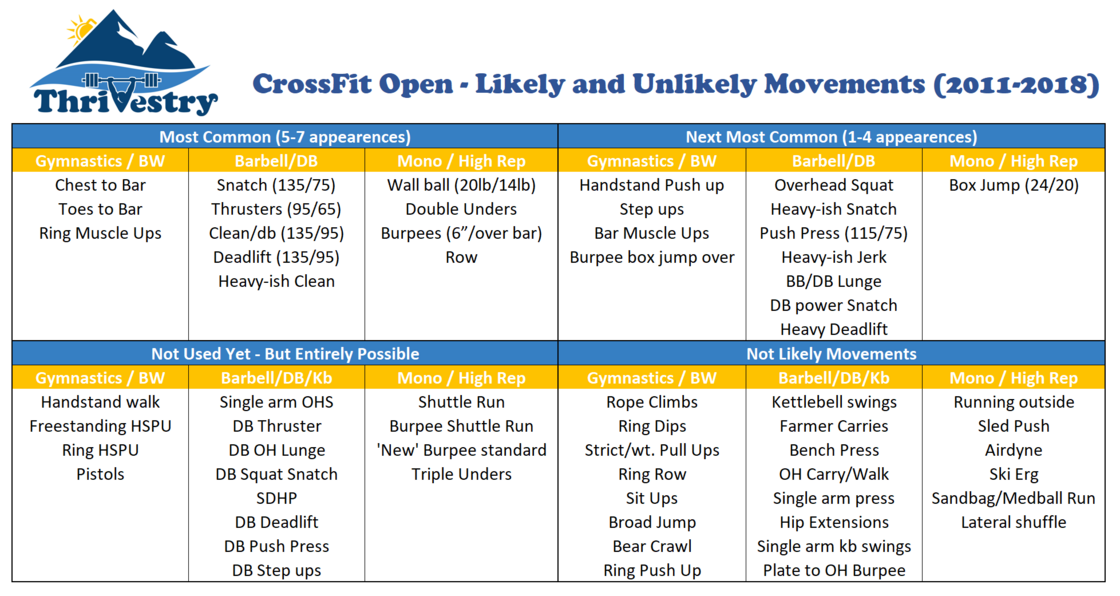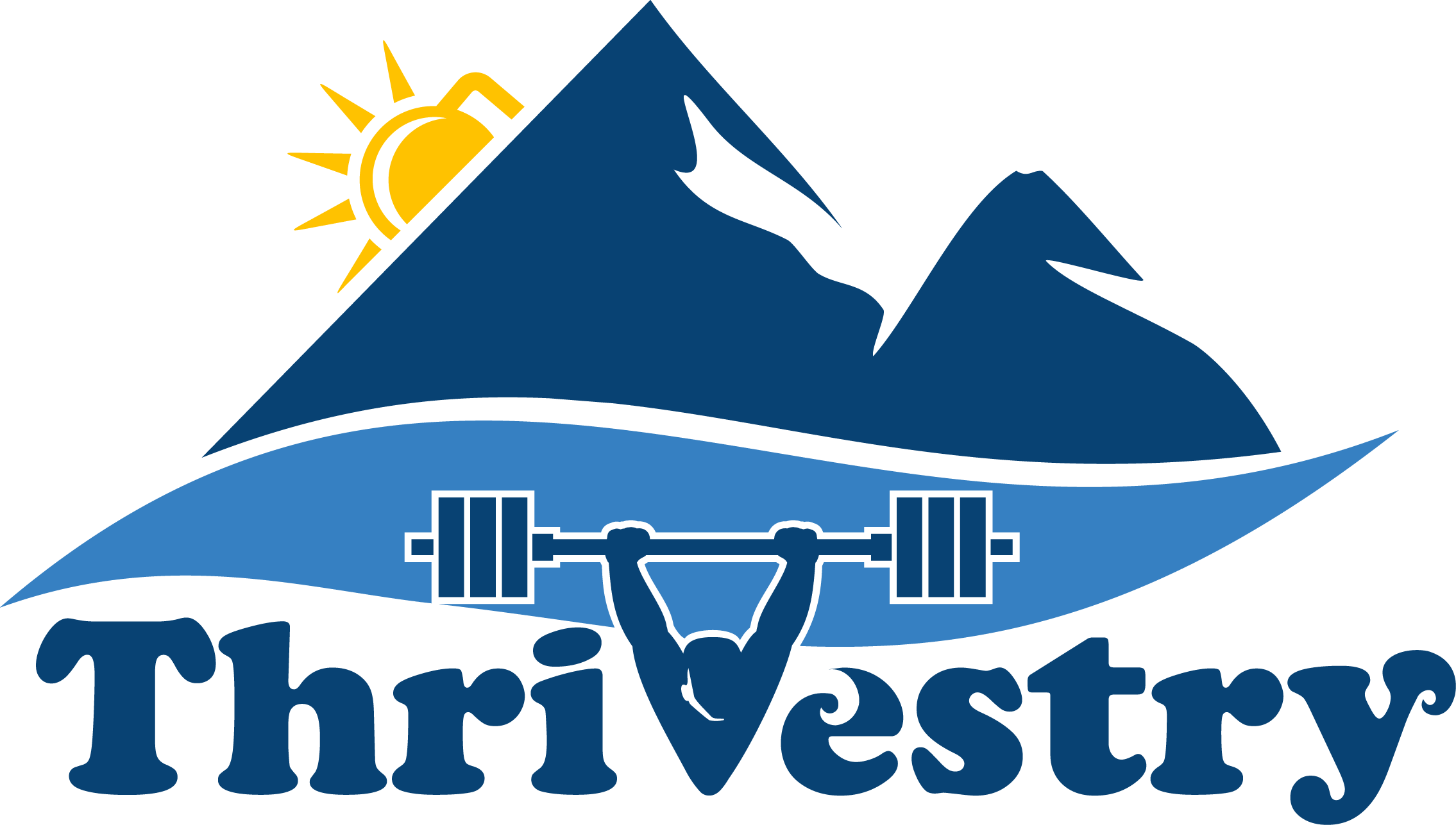Programming During the CrossFit Open
*** UPDATED FOR 2011-2018! ***
It is that time of year again.
I can hear the collective cheers and groans from CrossFit gym owners around the world… Another CrossFit Open!

I had the luxury of programming for 6 years before the first CrossFit Open in 2011, and I still had a lot to learn those first 7 years since then! In this article I am going to outline some of the best practices (and things to avoid) when programming during the Open. It is my goal to save you time during the stressful time of the Open, while still delivering a good experience to your members.
(TL;DR) Summary
- Start tweaking the programming in December.
- Don’t alienate the folks who aren’t “in” to the Open this year.
- Don’t ‘cram’ the month of February.
- ‘Save’ your non-Open movements for the first couple weeks.
- Plan on programming Thursday to Thursday.
- Keep your volume on the safe side.
- Each week, look at what has been programmed so far so it is easier to program in the later weeks.
Before the Open

This article would not be complete if we didn’t mention some of the prep work that should go into the programming before the Open. This could be a long article in itself, so I’ll just cover some of the high points here.
With Thrivestry, we start tweaking the programming back in late November / early December. The key here is that it isn’t a major shift. I still maintain that the gym programming should be focused on general physical preparedness (GPP), and not the sport of fitness. That said, we shouldn’t get carried away with programming Open workouts and movements day in and day out before the Open.
I’ve found that the best approach is to incorporate some of the Open workouts and do some skill work around key movements while maintaining our goal of making people better humans outside of the gym. The ‘tweak’ or ‘shift’ should be subtle, in that it isn’t really noticeable for our regular gym clients. While most gyms will have a significant number of people participate in the Open, we must keep in mind that forcing everyone to specialize in the training for the Open will move them away from GPP (and alienate those folks who aren’t interested in the Open this year).
It is also important to get people’s minds around the differences between being judged to an Open standard, and what they may normally do when they aren’t being watched by a judge. Throughout the year we can make sure people understand the differences between what may be acceptable (a scaled version) in regular programming and what is required in the Open (‘point A to point B’ movement). This will prevent people from getting frustrated with their judge because of ‘no reps’, and having a ‘bad Open’.
We will include additional skill work around movements like chest to bar pull ups, pull ups, and muscle ups. We make sure that our lifting focuses are setting people up for success for what is going to be important during the Open. For example, it isn’t that we aren’t going to do chest to bars the rest of the year, but we don’t want to be doing them with the detriment of avoiding strict chin ups or weighted pull ups. Kipping chest to bars are a good movement, but they were invented for competition. Chin ups and weighted pull ups (or progressions) need to be included in any ‘complete’ GPP program!
Avoid Skipping or Cramming
Two things to avoid is skipping preparation completely, or trying to ‘cram’ more the month or so before.
Skipping preparation completely is a recipe for disappointment for the folks who are keen on doing well in the Open. We want people to feel prepared for the Open, and be proud of how they did. If they haven’t spent any time working on getting that first chest to bar, or they aren’t used to being judged, they will end the Open on a low note (making them less likely to want to do it next year). It is our job as coaches to set them up for success so they look forward to the Open every year!
‘Cramming’ the month of the Open is also a problem. If we wait until February to start getting people’s minds around what is coming, they will not have the time to get better at those skills that can make or break a workout. In fact, highlighting their ‘weaknesses’ the weeks before the Open will make some people avoid the Open because they aren’t happy with their progress, and they don’t want to be embarrassed or frustrated because they can’t do the movements required.
It is also hard on people because the Open is already 5 weeks long. Cramming a bunch of Open workouts and movements the weeks before the Open starts is a sure way to burn people out and risk injures.

Click here to download PDF Version: CF_Open_Summary_-_Updated_thru_2018.pdf
Weeks going into the Open
Once we have prepared people for the Open, how should we approach the programming the weeks going into the Open?
In the weeks immediately before the Open, we want to include some of the more general movements we are likely to see going into the Open. Double unders, power snatches, toes to bar, etc. The reason we want to prioritize these is because we are going to avoid programming them the first week or two.
We will also want to avoid programming the movements that aren’t likely to show up (running, rope climbs, kettlebells, etc.) We want to ‘save’ these movements for those first couple weeks so we can use them strategically and avoid ‘over programming’ movements that are likely to show up.
I am not saying that you can’t program running workouts the week before the first week of the Open. It is just that if you program a bunch of running workouts that week, you don’t want to have to program them again the following week!

During the Open
If you are like most competent programmers, you will have your stuff figured out weeks (or months) in advance. The ‘unknown’ aspect of the Open can make any programmer break out into sweats (it has definitely kept me up at night in the past).
Previous years, I have gone through the effort of making multiple ‘tracks’ based upon what movement patterns came out. Plan A if has squatting and pull up type movements. Plan B if it is pulling and pressing, etc. This is a good option if you are really concerned about having a plan multiple weeks in advance, but it can double or triple the amount of work!
I have also found that most people tend to rest the day before they plan on doing the Open anyway. Having the ‘best’ workout planned for Open participants isn’t as critical as maintaining good overall programming for rest of the gym folks.
Similarly, if the Open workout was particularly brutal, most people will end up resting the day after. This reduces the importance of the day after programming for people focusing on the Open, and puts the priority back on keeping the ‘flow’ of the GPP programming.
With that in mind, we’ll start with shifting the programming to a 1-2 weeks in advance, and program out so that you ‘end’ your week on Thursday. For example, you’ll want to have the programming finished through Thursday, March 1st, so a week or two before the Open even starts.
We don’t know what will be coming out week 1, but we can use our ‘non Open’ movements to fill in that first week, to week and a half, of the Open. Hopefully, they will use a workout that has 3 or more movements so we can then use that to help us be smart about the programming in the subsequent weeks. A single movement planned will make it much more difficult (but not impossible)!
You can stretch this out to two weeks (programing to the third Thursday of the Open), but you’ll have to be ready to make some course corrections if what they put out interferes with what you had planned. The benefit of having it another week out is that you’ll have more time run the Open well in the gym, judge heats, approve scores, help people strategize, etc.
Once the workout is announced, you’ll have a better idea of what is left and you can program the subsequent week accordingly (again, ending on Thursday). As the weeks go on, it will get easier to ‘predict’ what is likely to show up, and you’ll be able to plan ahead more effectively!
Notes on Volume: It is important to keep volume in mind during the Open. Most people will go harder on the Open workouts than they normally do, and some people may even do the workout more than once. That means that you will want to avoid ‘hammering’ people with the programming between the Open workouts. Avoid workouts that are terribly long or cause a lot of soreness. Don’t program sets of movements that are more likely to tear hands or blow people’s backs up. Use rest intervals to moderate intensity and soreness.
Summary (again)
- Start tweaking the programming in December.
- Don’t alienate the folks who aren’t “in” to the Open this year.
- Don’t ‘cram’ the month of February.
- ‘Save’ your non-Open movements for the first couple weeks.
- Plan on programming Thursday to Thursday.
- Keep your volume on the safe side.
- Each week, look at what has been programmed so far so it is easier to program in the later weeks.
What do these ‘non-Open’ workouts look like anyway?
Below are a few examples of workouts that you can use the first couple weeks of the Open to make sure you aren’t repeating too many movements and ‘over stimulating’ your people. These are just the ‘metcon’ portion of the programming each day (not all other stuff like ‘skills’, ‘mobility’, ‘cash outs’, etc.). Feel free to use these those first weeks of the Open and/or use them for ideas of what you can program for your folks so they the best experience possible during the Open.
General Programming Examples
Metabolic Conditioning: "Six Shooter"
For Time, 6 rounds
6 Left leg pistol (Health: one legged box squat / Athletic*: 15lb / Performance: 35lb)
6 Right leg pistol (same)
6 dumbbell weighted pull-up - kipping allowed (Health: band assisted / Athletic*: 15lb / Performance: 35lb)
200m run
*Women’s “Performance” weights and reps (Rx)
Scaling Guide: 11 – 20 minutes (24 min time cap)
Coaching Tips: Hold the kettlebell / dumbbell however you would like to make the pistol happen (at the shoulder, out in front, etc.); the scaling of the pistols will be a very strong factor in finish time. If you can't do a pistol, choose a box that allows you to sit and stand on one leg. You can vary the box height by using plates on a low box OR by putting the plate on the ground and then standing on it (for example a black 45lb plate will make a 20" box 16" this way). Use the same kettlebell / dumbbell for the weighted pull-ups.
Metabolic Conditioning: “Evasion 2.0“
Cover as much distance as possible in 25 minutes
Row, run, DU, Airdyne split as desired but…
Minimum 1500m row
Minimum 1200m run req.
Minimum 200 Double unders
MAX: 4,800m on assault/airdyne (3 miles)
Double unders (Each DU counts as 3 meters for scoring purposes)
Airdynes/bike/ski ergs included (no minimums or maximums)
*Women’s “Performance” weights and reps (Rx)
Scaling Guide: 4000-6500 meters
Coaching Tips: Plan on rotating between movements multiple times. Many people find it beneficial to start with larger ‘sets’, then to decrease the distances as the rounds progress. Starting with 100 double unders, then 1000m of rowing, then 800m of running, then doing 50 double unders, 800m of rowing and 600m of running, etc. Mix it up as much as you want, but be wary that the transitions will cost you time. As the time comes to a close, don’t run out too far from the clock (to make the distance traveled easier to estimate).
Metabolic Conditioning: “Year End Goals” (YEG) and ‘Max’ Effort Testing
Choose 2 – 3 to test. Try to do one Strength movement, one Gymnastic, and one small Met-Con. Test Front squat if you didn't get a chance to earlier this month, test front squats. Here are a some ideas on what to test (But don’t feel limited by this list)
Max weight from the floor to overhead (Clean and Jerk)
Max consecutive push-ups (no dropping off of toes)
Max sit-ups in a minute (abmat, feet unanchored)
Max consecutive kipping pull ups (not dropping off the bar, interrupted kipping is fine)
Max consecutive strict pull ups
“Annie” 50-40-30-20-10 Double unders and sit ups (for time)
“Baseline” 500m row, 40 squats, 30 sit-ups, 20 push-ups, 10 pull-ups (for time)
Coaching Tips: This is not meant to be a haphazard open gym day - work together in groups so you can have people to do the tests with, and/or help you count reps. Be smart about the order of the movements (you don’t want to do something that will hurt the results of the next thing). If you missed the front squat testing, I recommend doing that as one of the tests today.
Short Workout Examples (for pairing with lifts)
Metabolic Conditioning: “Tabata Sled Pushes – Part Deux”
TABATA - 20 seconds on, 10 seconds of rest, 8 rounds (4 minutes total)
Record TOTAL repetitions of 20’ low, 20’ high sled push, operating in the Tabata framework. Each direction equals one “rep” (one round trip is two reps).
Health: +50lbs, Athletic*: +90lbs, Performance: +140lbs
*Women’s “Performance” weights and reps (Rx)
Scaling Guide: 16-36 reps
Coaching Tips: If you finish with the sled partway through an interval, just leave it there for the next round and pick up where you left off (that is why we are counting total reps and not just minimum reps per round). Be conservative in the beginning rounds. Use short choppy steps to get the sled started. You can turn the sled around if you are using a sled with low and high handles so you only have to use the ‘high’ side, but it will cost you time. You will also want to give the sled a good ‘shove’ with the arms at the call of “Rest”.
Metabolic Conditioning: "Peter and the Wolf"
7 minute AMRAP
100m sprint (= 1 “rep) or 20’ shuttle run -no line touch-, 6 round trips
2 ‘heavy’ kettlebell swings –American- (Health: 35lbs, Athletic*: 53lbs, Performance: 70lbs)
100m sprint (= 1 “rep)
4 ‘heavy’ kettlebell swings, 100m sprint (= 1 “rep)
6 ‘heavy’ kettlebell swings, 100m sprint (= 1 “rep)
8 ‘heavy’ kettlebell swings, 100m sprint
Etc. (until the time runs out, keep doing one sprint, and adding two reps to the kb swings).*Women’s “Performance” weights and reps (Rx)
Scaling Guide: 40-100 reps, (Finishing the 10s or more)
Coaching Tips: Go with a heavier weight kettlebell than what you may actually use in a longer metcon. Try to do at least the first few rounds ‘RX’. As the workout goes on and your form starts to degrade, don’t change kettlebell weight! Just scale down to “Russian” height (stopping at eye level) for the later rounds. Sprint hard the first few rounds because the kettlebell swings are so short. As the sets get larger, plan on slowing down the runs so that you get a bit more rest between each set of swings. Maintain strict form on the swings with an upright torso (no tipping over!) and no ‘front raises’ with the shoulders. If you want to ‘two hand kb snatch’ the bell overhead – go for it. Just remember that the faster snatch style tends to pack an intensity wallop as well as blow your grip up.
Metabolic Conditioning: “Fortunate Son” (an ‘Old School’ CrossFit Classic)
For time, 3 rounds
12 front squats -from the floor- (Health: 65lbs / Athletic: 95lbs* / Performance: 135lbs)
12 burpee pull-ups
*Women’s “Performance” weights and reps (Rx)
Scaling Guide: 4 – 10 minutes. Scale Up: OHS instead of front squats. Some may consider doing this for just the first round.
Coaching Tips: Being able to do the first round of front squats unbroken is not a requirement (but it is probably a good idea as a rough guide for scaling). Ideally the third round should only be broken up into no more than 3 sets. Even less is better. Scale down and take the bar out of the rack if the squatting part is the easy part (and the clean is the difficult part). If you squat clean the first rep in a set, it counts as a ‘front squat’!
For the burpee pull ups, the bar needs to be higher than your reach. As in: if you stand flat footed with your arms above your head, you are not able to grasp the pull up bar in the palm of your hand. Anything higher is extra.
Team Workout Examples (good for weekends)
Metabolic Conditioning: “Scully and Mulder”
25 minute AMRAP (as many rounds as possible), partner workout
30 Bench Press or Floor press (Health: 35lb / Athletic*: 65lb / Performance: 155lb) - split reps up as desired
Then max rounds
Row (Health: 800m / Athletic: 900m* / Performance: 1000m) – split as desired
30 (total) Partner push-ups with hand clap – one person can do more reps than the other, but the second partner must stay in the plank (video)
30 hip extensions* split as desired (sub 20lb/14lb good mornings if there aren’t enough GHDs)
30 (total) partner med ball pass sit-ups (Health: 10lb / Athletic: 14lb* / Performance: 20lb) (video)
100m Sandbag run (Health: 45lb / Athletic: 60lb* / Performance: 80lb) – both partners must run, switch off carrying the sandbag as desired. Indoors: 20' run, 5 round trips
*Women’s “Performance” weights and reps (Rx)
INDY VERSION: 15 bench press, then max rounds 500m row, 15 push ups, 15 hip extensions, 15 sit ups, 50m sandbag run, 1 min rest.
Scaling Guide: 4-6 rounds
Coaching Tips: This one starts with a bench press buy in. Have partners spot each other (everyone uses a spotter)! If you have someone who is better at bench (or any movement today for that matter) do some extra work to give their partner more rest and move more efficiently as a team. The partner push-ups are where both partners do push-ups with the tops of their heads near each other. At the top of each rep, they must slap hands (right to right, left to left, etc.). The rep count is for total reps, so that means that if each partner does a rep and slap, they will do 15 reps in unison. If one partner wants to do more of the push-ups they can, but the other partner has to stay at the top of the push up position and slap hands every rep. The same for the sit-ups (the person must stay at the top).
Metabolic Conditioning: “This is my bumper, there are many like it“
20 minute AMRAP (as many rounds as possible) PARTNER workout.
400m bumper plate farmer carry (Health: 25lb dumbbells / Athletic*: 25lb / Performance: 45lb) both partners run together (OR 20' out and back shuttle with plates x 15 times)
25 bumper plate burpees (same weight, Health: 15lb plate)
25 bumper plate squats (hug plate to chest) (same)
25 supine ring rows
*Women’s “Performance” weights and reps (Rx)
Scaling Guide: 2 – 4 rounds, about 6 minutes per round.
Indy Version: 200m farmer carry, 12 bumper plate burpees, 12 bumper plate squats, 12 ring rows, 1 minute rest, AMRAP 20 min
Coaching Tips: Don’t worry about splitting the work evenly. If one person is faster on one movement than the other have them do more reps. This will increase your overall speed for the whole workout is faster ensuring both of you get an equally hard workout. Trade often on the farmer carries, it will pay off big time on the later rounds. The same thing goes for the burpees. Go a little bigger on the squats and the ring rows. Remember to shift the reps to the partner who is going to do better at it!
The Wrap Up
I hope these tips help you thrive during the Open this year and future years! Having a plan for the Open is always going to be better than 'winging it' when you have so many other things to focus on. Don't forget to review this article again next season starting in December to get ready for the Open ahead of time!
You also won't want to miss our "Open Strategy Sessions" the night of the workout announcements. We'll post them here to the blog for you to share with your clients. Here is an example from 2017.
Thrive on.
-jj

0 comments
Leave a comment